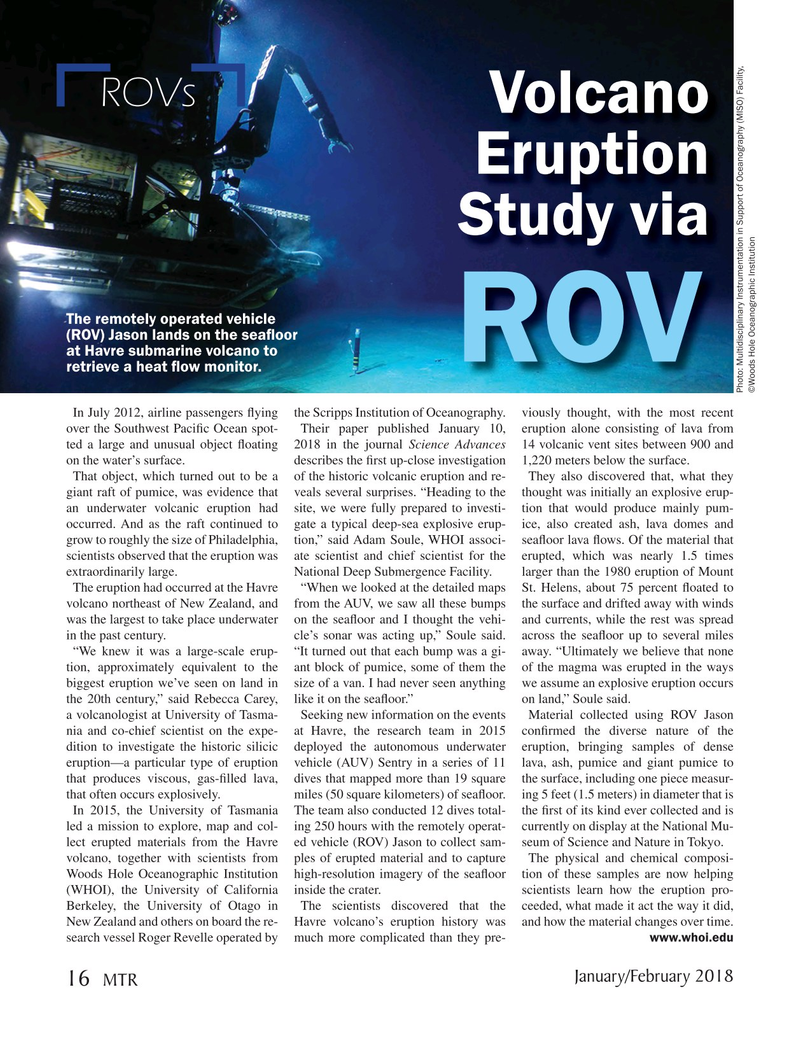
Page 16: of Marine Technology Magazine (January 2018)
Underwater Vehicle Annual: ROVs, AUVs and UUVs
Read this page in Pdf, Flash or Html5 edition of January 2018 Marine Technology Magazine
ROVs
Volcano
Eruption
Study via
The remotely operated vehicle (ROV) Jason lands on the sea? oor at Havre submarine volcano to
ROV retrieve a heat ? ow monitor.
Photo: Multidisciplinary Instrumentation in Support of Oceanography (MISO) Facility, ©Woods Hole Oceanographic Institution
In July 2012, airline passengers ? ying the Scripps Institution of Oceanography. viously thought, with the most recent over the Southwest Paci? c Ocean spot- Their paper published January 10, eruption alone consisting of lava from ted a large and unusual object ? oating 2018 in the journal Science Advances 14 volcanic vent sites between 900 and on the water’s surface. describes the ? rst up-close investigation 1,220 meters below the surface.
That object, which turned out to be a of the historic volcanic eruption and re- They also discovered that, what they giant raft of pumice, was evidence that veals several surprises. “Heading to the thought was initially an explosive erup- an underwater volcanic eruption had site, we were fully prepared to investi- tion that would produce mainly pum- occurred. And as the raft continued to gate a typical deep-sea explosive erup- ice, also created ash, lava domes and grow to roughly the size of Philadelphia, tion,” said Adam Soule, WHOI associ- sea? oor lava ? ows. Of the material that scientists observed that the eruption was ate scientist and chief scientist for the erupted, which was nearly 1.5 times extraordinarily large. National Deep Submergence Facility. larger than the 1980 eruption of Mount
The eruption had occurred at the Havre “When we looked at the detailed maps St. Helens, about 75 percent ? oated to volcano northeast of New Zealand, and from the AUV, we saw all these bumps the surface and drifted away with winds was the largest to take place underwater on the sea? oor and I thought the vehi- and currents, while the rest was spread in the past century. cle’s sonar was acting up,” Soule said. across the sea? oor up to several miles “We knew it was a large-scale erup- “It turned out that each bump was a gi- away. “Ultimately we believe that none tion, approximately equivalent to the ant block of pumice, some of them the of the magma was erupted in the ways biggest eruption we’ve seen on land in size of a van. I had never seen anything we assume an explosive eruption occurs the 20th century,” said Rebecca Carey, like it on the sea? oor.” on land,” Soule said.
a volcanologist at University of Tasma- Seeking new information on the events Material collected using ROV Jason nia and co-chief scientist on the expe- at Havre, the research team in 2015 con? rmed the diverse nature of the dition to investigate the historic silicic deployed the autonomous underwater eruption, bringing samples of dense eruption—a particular type of eruption vehicle (AUV) Sentry in a series of 11 lava, ash, pumice and giant pumice to that produces viscous, gas-? lled lava, dives that mapped more than 19 square the surface, including one piece measur- that often occurs explosively. miles (50 square kilometers) of sea? oor. ing 5 feet (1.5 meters) in diameter that is
In 2015, the University of Tasmania The team also conducted 12 dives total- the ? rst of its kind ever collected and is led a mission to explore, map and col- ing 250 hours with the remotely operat- currently on display at the National Mu- lect erupted materials from the Havre ed vehicle (ROV) Jason to collect sam- seum of Science and Nature in Tokyo.
volcano, together with scientists from ples of erupted material and to capture The physical and chemical composi-
Woods Hole Oceanographic Institution high-resolution imagery of the sea? oor tion of these samples are now helping (WHOI), the University of California inside the crater. scientists learn how the eruption pro-
Berkeley, the University of Otago in The scientists discovered that the ceeded, what made it act the way it did,
New Zealand and others on board the re- Havre volcano’s eruption history was and how the material changes over time.
search vessel Roger Revelle operated by much more complicated than they pre- www.whoi.edu January/February 2018 16 MTR
MTR #1 (1-17).indd 16 MTR #1 (1-17).indd 16 1/25/2018 9:43:00 AM1/25/2018 9:43:00 AM

 15
15

 17
17
